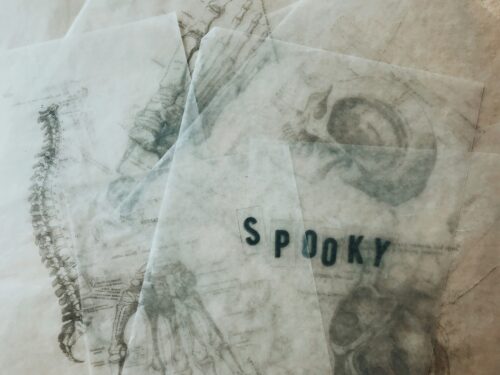3 Writing Prompts for YA Horror

The right horror writing prompts can take your writing to the next level by helping you find the unexpected and the strange within your own story.
By E.G. Young
July 30th, 2025
Let’s pretend we’re sitting around a campfire at a writer’s retreat, flashlights under our chins, swapping our favorite horror prompts. I’ll go first, because I love writing prompts.
In fact, prompts are a big reason I was able to finish my debut novel, A (Dead) Thing Like Me, a paranormal fantasy with spooky elements. These prompts helped me let go of my logical, conscious mind and explore all the strange, hidden depths of my fictional world.
That’s what a good horror prompt does: it reveals the unexpected as it immerses you in your story. I’m always looking for new ones, so please share your favorites in the comments below! (I’ll pass the flashlight to hold under your chin.)
Here’s three of my favorite horror writing prompts:
- Prompt 1: The Five Senses
- Prompt 2: The Monstrous POV
- Prompt 3: The Fear
Prompt 1: The Five Senses
In her excellent article on YA horror, horror writer Alexis Powell explains that when we read, our brains can’t tell the difference between fiction and reality. Powell quotes writer Sydney Stevic on the psychology of horror:
“When we read a scary story, our brains react as if the danger is real, releasing adrenaline and other stress hormones that put us on high alert.” –Sydney Stevic
This allows readers to practice living through scary moments so we can face them in the real world. (In fact, horror fans were more psychologically resilient during the pandemic).
Before I write anything, I do the following five senses prompt. It’s especially useful for spooky scenes, because the more sensory they are, the better.
The Prompt
- Find a song that conveys the emotions of your scene. Listen to it until you feel transported to your scene, almost in a trance.
- Ask yourself questions. What is my character seeing/hearing/feeling/touching/tasting?
- When you get an answer, dig deeper. If she’s wading into cold, dark lake water, what does that feel like? Can she hear anything move in the water? Does a drop of it get on her tongue? What does it taste like? What does it remind her of?
- Now go even deeper. Ask why. Why does it remind her of this?
- Write down the answers quickly, and don’t worry about spelling or grammar.
- Do this for all five senses.
- At the end, you should have pages and pages of details. You won’t use them all in the scene, but now you have a treasure trove to pull from. And, if you keep asking why, you might also get important character revelations.

You can use horror writing prompts to challenge yourself and dig into your story. Ask yourself tough questions and challenge yourself to rethink conventional monsters.
Prompt 2: The Monstrous POV
Who is the protagonist of your horror story? Maybe it’s time to embrace your inner monster!
While researching horror fiction, librarian Taylor Hunsberger found that children’s horror is unique, because it centers the experiences of monsters.
“The primary difference I began to find within these books was that some stories included a monster as a protagonist rather than as a threat to the main character.” —Taylor Hunsberger
She found this is especially true for picture books and early readers, but you can apply this technique to young adult fiction too. After all, teens feel truly Othered from the world. They’re going to relate to misunderstood monsters. (And as writers, we will too.)
The Prompt
- If you were a paranormal creature or classic monster, what would you be? What do you relate to the most? (Sidenote: this prompt is how I ended up writing a novel about a ghost who just wants a hot dog). If something jumps to mind, you’ve got your protagonist.
- If you don’t immediately resonate with a monster, try this: Write down the names of several archetypal/fairytale monsters (Big Bad Wolf, swamp monster, vampire, ghost, zombie), each on their own scrap of paper.
- Now write down different goals or desires they could have, also on their own scraps of paper. Mix them up in a hat. Pull out a creature (vampire) and a desire (to be loved) or goal (to have a date by the Valentine’s Day dance). Keep going until you find a combination you like.

Understanding how to write fear effectively is the key to writing YA horror stories. Start with a writing prompt that asks you to explore the emotion and dig into what scares your character.
Prompt 3: The Fear
What creepy antagonist is your character up against?
You can devise the most horrifying villain (a zombie clown, in my opinion!), but if your character isn’t afraid of zombies or clowns, it’s not going to be effective.
First, you need to figure out what they’re afraid of—on a deep, visceral level—and what they need to face.
In her craft books, Story Genius and Wired for Story, author Lisa Cron suggests that a character needs to change because they have a “false belief” about themselves and their world. This false belief stems from an emotional wound your character suffered in their past. The events of the story must force them to confront their false belief and heal their emotional wound.
Cron advises us to write about their “emotional wound” as a full-fledged scene:
“Don’t be worried if it takes several tries to nail it. Feel free to test several scenarios until you hit on the one that feels right… Chances are there will be moments in your own life that will leap to mind, providing evocative material just waiting to be mined. After all, what ‘write what you know’ really means is, write what you know emotionally.” –Lisa Cron
The Prompt
- First, use Cron’s prompt: write the moment your character suffered an emotional wound that changed how they view themselves and others. Note that this moment does not have to be huge, it just has to be huge for your character.
- Now that you know their deepest wound, what is their greatest fear?
- Is this a story of redemption, acceptance, self-love? (Save the Cat Writes a Novel by Jessica Brody has an excellent list of possible themes if you want inspiration.)
- What antagonist would force your character to go on this thematic journey and face their fear?
- How might you create an antagonist that is a manifestation of their fear/emotional wound?
Follow the Campfire Rule
Wherever your prompts lead you, remember the campfire rule: always leave your readers better than when you found them, as author Ben Philippe says. The goal of YA horror is to help readers experience catharsis and gain a sense of their own power from “living through” these fictional frights.

E.G. Young
EGYoungbooks.comE.G. Young writes speculative fiction about strange girls. Her YA ghost novel, A (Dead) Thing Like Me, comes out summer 2026 with Holiday House, and she was the former co-editor of the horror ezine The Quiet Ones. Emily holds an MFA in Writing for Children & Young Adults from The Vermont College of Fine Arts and is always hoping to meet a (friendly) ghost. If you want more craft discussions, ghost stories, and too many pet photos, follow Emily on Instagram at @egyoungbooks!
Related Posts
- A Deep Dive Into Film Scoring Opportunities May 28, 2025
- Artist Grants: What They Are, Where to Find Them, and How to Apply Aug 01, 2025
- Beyond Quotation Marks: How to Write Dynamic Dialogue Jun 02, 2025

